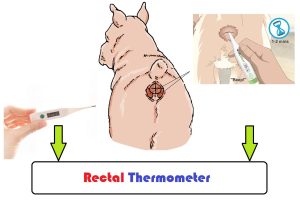When it comes to our furry companions, keeping them healthy is a top priority. One important thing to know about a dog’s health is its body temperature. Just like humans, dogs have a normal body temperature range that serves as a vital indicator of their well-being. In this article, we will explore How can you tell if your dog has a fever. Can you check their temperature at home safely? And if you do, how can you know if it’s too high or not? Let’s learn how to recognize signs of a fever in your dog and what’s a normal temperature for them.
What is a dog’s normal body temperature?
Just like people, dogs have a normal range of body temperature that tells us how well they are feeling. Dogs usually have a body temperature between 99.5°F to 102.5°F (37.5°C to 39.2°C). This range of temperature might slightly vary up or down, depending on some factors like breed, stress, age, and size. Keep in mind that puppies and smaller breeds usually have slightly higher than normal body temperatures. But If a dog’s body gets too hot, it might have a fever or be overheating. On the other hand, if a dog’s body gets too cold, it might be experiencing hypothermia.
You may like to read: Why do female Dogs Cry When Mating?
Variations in Temperature:
Dogs are a lot like us in some ways. Just like how we can feel a little warmer or cooler at times, dogs can also have their body temperature go up and down during the day. Things like how active they are, if they’re feeling stressed, or the weather can make their temperature change a bit. But it’s really important to notice when their temperature changes a lot because that could mean they’re not feeling well.
How To Measure A Dog’s Temperature?
For measuring the dog’s temperature, we can use a thermometer, so there are two types of thermometers specifically designed for pets:
- Rectal thermometers
- Ear thermometers
Rectal Thermometer:

To measure your dog’s temperature accurately, you’ll need a digital rectal thermometer specifically designed for pets. These thermometers are safe, easy to use, and provide precise readings.
- Prepare the thermometer:
- Put some water-based lubricant on the thermometer’s tip for a safe and comfy insertion.
- Restrain your dog:
- Hold your dog gently but securely or ask for help.
- Make sure your dog is calm to reduce stress.
- Insert the thermometer:
- For small dogs, insert it about 1 to 1.5 inches deep.
- For larger breeds, go in about 2 to 3 inches.
- Wait for the reading:
- Keep the thermometer inside for about a minute or until it beeps, which means it’s done measuring.
- Record the temperature:
- Carefully take out the thermometer and write down the temperature.
Ear Thermometers:
You’ll need a digital ear thermometer specifically designed for dogs. These thermometers are available at most pet supply stores or online. For many dog owners, ear thermometers are easier to use because they tend to be less uncomfortable for the dog. When using an ear thermometer, you should gently place it in a dog’s ear while following the instructions carefully.
- Gather Your Supplies:
- Get alcohol wipes or cotton balls to clean the thermometer and your dog’s ear.
- Get Ready:
- Find a quiet, comfy spot to do this.
- Make sure your dog is relaxed or have someone help hold them still.
- Clean the Ear:
- Use an alcohol wipe or cotton ball with rubbing alcohol to clean the thermometer.
- Gently clean the entrance of your dog’s ear.
- This helps with accurate readings and avoids infections.
- Insert the Thermometer:
- Turn on the ear thermometer and follow the instructions.
- Put the probe into your dog’s ear, but don’t push too hard.
- Be careful not to hurt your dog’s eardrum.
- Wait for the Reading:
- Keep the thermometer steady.
- Wait for a few seconds until it beeps or signals that it’s done.
- Record the Temperature:
- Carefully take out the thermometer and note the temperature.
You may like to read: How Often Do Dogs Need Rabies Shots?
What Does It Mean When A Dog’s Temperature Is Too High?
If your dog’s temperature goes above 102.5 degrees Fahrenheit, they might have a fever or heat stroke. We’ll tell you the signs and how to cool them down when they’re too warm.
Signs Of Heat Stroke In Dogs:

Hot weather can be really bad for dogs. Heat stroke happens when they get too hot. It’s very dangerous, so it’s best to keep them cool. Look out for these signs of heat stroke in dogs.
- Excessive Panting and Drooling
- Elevated Body Temperature
- Rapid Heart Rate
- Bright Red Gums and Tongue
- Weakness and Lethargy
- Vomiting and Diarrhea
- Collapse or Loss of Consciousness
- Seizures
- Excessive Salivation
- Dilated Pupils
Heat stroke in dogs is very serious and can be life-threatening. If you think your dog has it, call the vet right away. They can tell you how to cool your dog down safely at home, which might save their life.
How To Safely Lower A Dog’s Body Temperature?
Here are some tips that can help you safely lower a dog’s body temperature:
- Lower a dog’s body temperature slowly to prevent hypothermia.
- Contact a vet while monitoring the dog’s temperature regularly.
- Use air conditioning or provide drinking water for mild overheating.
- Without air conditioning, dampen the dog with cool, not cold, water, avoiding the face and submersion.
- Ensure a gradual and cautious approach to cooling the dog.
Signs Of Fever In Dogs:

Dogs can get fevers from viral or bacterial infections or toxic substances. Signs of a fever in dogs include:
- Lethargy
- Warm, Dry Nose
- Increased Heart Rate
- Coughing and Sneezing
- Dehydration
Fever in dogs often means they’re unwell or have a serious infection. So, when you think your dog might have a fever from a germ or virus, it’s better to go to the vet right away for help and care.
How To Reduce Fever In Dogs?
If your dog has a fever, try gently wetting their paws and ears with cool water. It’s important to visit the vet for proper treatment and to find out why your dog has a fever.
You may like to read: How to Make a Dog’s Testicle Drop: A Step-By-Step Guide
What Does It Mean When A Dog’s Temperature Is Too Low?
When a dog’s body temperature drops below 99.5 degrees Fahrenheit, it can suffer from hypothermia, which can vary in seriousness. The signs of hypothermia in dogs include:
- Shivering
- Cold Ears and Paws
- Pale Gums
- Muscle Stiffness
- Slow Heart Rate and Breathing
- Low Body Temperature
How To Raise A Dog’s Body Temperature?
- To raise a dog’s body temperature, place them in a warm room or car.
- Wrap the dog in a dry, warm towel or blanket.
- Use cloth-covered hot water bottles for extra warmth.
- Keep it gradual to avoid overheating.
- Ensure a controlled warming process.
You may like to read: Why Do Dogs Drag Their Butts On The Ground?
FAQS: What Is A Dog’s Normal Temperature?

Still not satisfied here are some frequently asked questions:
How do you know if your dog has a fever?
The best way to check if your dog has a fever is by using a dog-friendly digital Rectal thermometer at the bottom.
Can you use a human thermometer on the dog?
Yes, You can use any thermometer, even one made for people, to check your dog’s temperature. Digital thermometers are better because they work faster.
How can I treat my dog’s fever at home?
To help your dog feel better when they have a fever, wet a cloth with cool water and put it on their ears and paws. Use a fan nearby. When their temperature goes below 103 F, stop. Keep watching them to make sure the fever doesn’t go up.
How do you tell if a dog has a fever without a thermometer?
Here are the most common signs:
- Lethargy
- Warm, Dry Nose
- Increased Heart Rate
- Coughing and Sneezing
- Dehydration
Is dog fever serious?
Yes, If your dog seems sick, try checking their temperature at home. If it’s higher than 102.5ºF, it’s time to see the vet.

